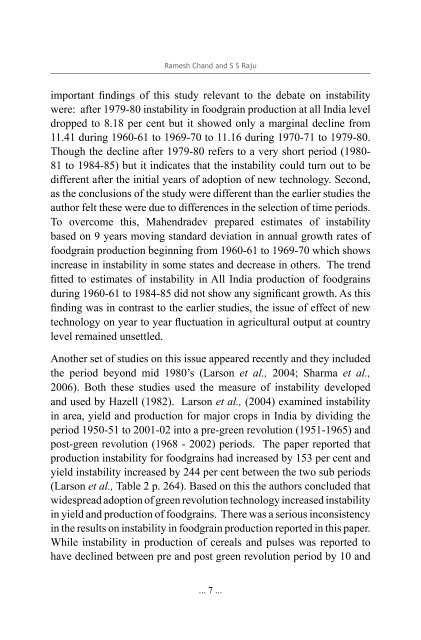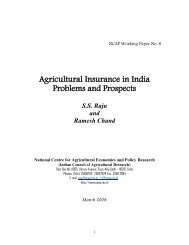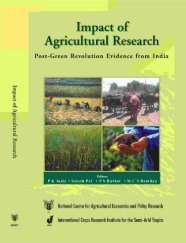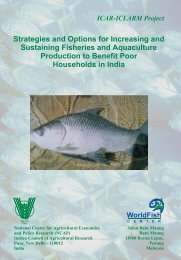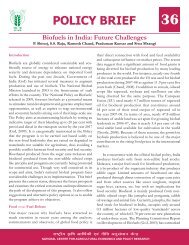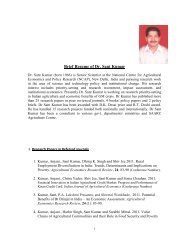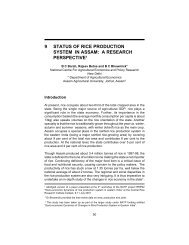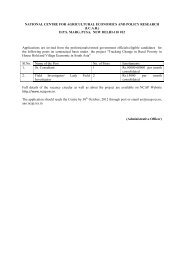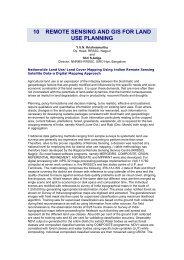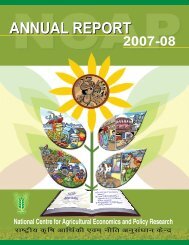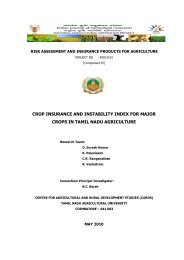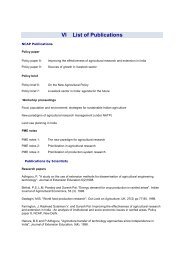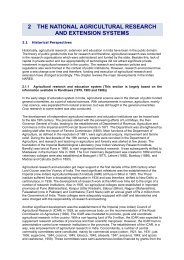Instability in Indian Agriculture - NCAP
Instability in Indian Agriculture - NCAP
Instability in Indian Agriculture - NCAP
You also want an ePaper? Increase the reach of your titles
YUMPU automatically turns print PDFs into web optimized ePapers that Google loves.
Ramesh Chand and S S Raju<br />
important f<strong>in</strong>d<strong>in</strong>gs of this study relevant to the debate on <strong>in</strong>stability<br />
were: after 1979-80 <strong>in</strong>stability <strong>in</strong> foodgra<strong>in</strong> production at all India level<br />
dropped to 8.18 per cent but it showed only a marg<strong>in</strong>al decl<strong>in</strong>e from<br />
11.41 dur<strong>in</strong>g 1960-61 to 1969-70 to 11.16 dur<strong>in</strong>g 1970-71 to 1979-80.<br />
Though the decl<strong>in</strong>e after 1979-80 refers to a very short period (1980-<br />
81 to 1984-85) but it <strong>in</strong>dicates that the <strong>in</strong>stability could turn out to be<br />
different after the <strong>in</strong>itial years of adoption of new technology. Second,<br />
as the conclusions of the study were different than the earlier studies the<br />
author felt these were due to differences <strong>in</strong> the selection of time periods.<br />
To overcome this, Mahendradev prepared estimates of <strong>in</strong>stability<br />
based on 9 years mov<strong>in</strong>g standard deviation <strong>in</strong> annual growth rates of<br />
foodgra<strong>in</strong> production beg<strong>in</strong>n<strong>in</strong>g from 1960-61 to 1969-70 which shows<br />
<strong>in</strong>crease <strong>in</strong> <strong>in</strong>stability <strong>in</strong> some states and decrease <strong>in</strong> others. The trend<br />
fitted to estimates of <strong>in</strong>stability <strong>in</strong> All India production of foodgra<strong>in</strong>s<br />
dur<strong>in</strong>g 1960-61 to 1984-85 did not show any significant growth. As this<br />
f<strong>in</strong>d<strong>in</strong>g was <strong>in</strong> contrast to the earlier studies, the issue of effect of new<br />
technology on year to year fluctuation <strong>in</strong> agricultural output at country<br />
level rema<strong>in</strong>ed unsettled.<br />
Another set of studies on this issue appeared recently and they <strong>in</strong>cluded<br />
the period beyond mid 1980’s (Larson et al., 2004; Sharma et al.,<br />
2006). Both these studies used the measure of <strong>in</strong>stability developed<br />
and used by Hazell (1982). Larson et al., (2004) exam<strong>in</strong>ed <strong>in</strong>stability<br />
<strong>in</strong> area, yield and production for major crops <strong>in</strong> India by divid<strong>in</strong>g the<br />
period 1950-51 to 2001-02 <strong>in</strong>to a pre-green revolution (1951-1965) and<br />
post-green revolution (1968 - 2002) periods. The paper reported that<br />
production <strong>in</strong>stability for foodgra<strong>in</strong>s had <strong>in</strong>creased by 153 per cent and<br />
yield <strong>in</strong>stability <strong>in</strong>creased by 244 per cent between the two sub periods<br />
(Larson et al., Table 2 p. 264). Based on this the authors concluded that<br />
widespread adoption of green revolution technology <strong>in</strong>creased <strong>in</strong>stability<br />
<strong>in</strong> yield and production of foodgra<strong>in</strong>s. There was a serious <strong>in</strong>consistency<br />
<strong>in</strong> the results on <strong>in</strong>stability <strong>in</strong> foodgra<strong>in</strong> production reported <strong>in</strong> this paper.<br />
While <strong>in</strong>stability <strong>in</strong> production of cereals and pulses was reported to<br />
have decl<strong>in</strong>ed between pre and post green revolution period by 10 and<br />
... 7 ...


